
before

before

Well, it's almost edible.
Bloggy posts something about the progress of freedom in Iraq.
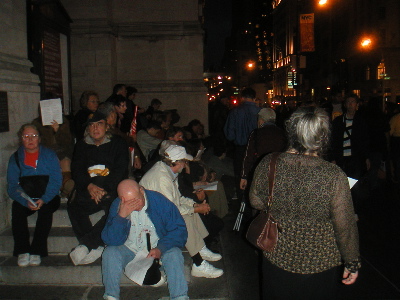
sounds of the city: part of the audience for John Cage's "Music for Carillon"
I love John Cage's music, always have, but even I understand that not all of it is lovable.
Late Sunday afternoon it was totally delightful. Sunday evening was a different story. The "Music for Carillon" which engaged much of Fifth Avenue at dusk reflected both the beauty of his art and the playfullness of the man. There was no way for devotees to avoid the ambient sounds of a busy city and there was no way the busy city (or at least that part of it) could avoid the musical occasion.
Best parts: the smiles, and watching the music engage and sometimes totally arrest passersby, especially children; oh, and listening to the counterpoint added by the beep beep beep of the front-end loader across the street.
The NYTimes reviewer referred to the "humming Cagean symphony of the street." I wonder if he had also been at Saturday afternoon's performance by Margaret Leng Tan of Cage's "Sonatas and Interludes for Prepared Piano".
That day's musical experience would have been perfection but for the regular interruption of rehearsal sounds and security guard radio conversations throughout. This time Zankel Hall's persistent subway sounds were totally overwhelmed by totally avoidable screw-ups. Ms. Tan briefly interrupted her performance early on and turned to the audience, smiling, to comment, "This is something of a Cagean moment." In spite of continual distractions, she went on to play magnificently for almost another hour. Unfortunately Cagean moments would not have been embraced even by Cage until the fifties, years after he had composed the delicate piece she was performing. Carnegie Hall owes her and the audience a formal apology.
Sunday night was . . . interesting. But for me, and also at least for the same Times reviewer, Jeremy Eichler, who had reported on the Carillon concert, it was a disappointment. Three extremely austere pieces were programmed for the evening, "Music for Three (by One)," excerpts from "James Joyce, Marcel Duchamp, Erik Satie: an Alphabet" and Cage's "Winter Music," was performed simultaneously with a solo vocal work from his "Song Books." Eichler laments:
More Cage followed that night at Zankel Hall, where 15 pianos were strewn across the stage and balconies, conjuring hopes of more exhilarating sonic anarchy, but alas it was not to be.Oh yes, these concerts were all part of the "When Morty Met John..." festival, of which the highlight was almost certainly Morton Feldman's Second Quartet. John Rockwell reviewed that performance, but he must have missed the "Sonatas and Interludes" excitement of that afternoon, because he praised Zankel Hall's "acoustically sealed" insulation and its impressive doors, writing that passing through them was "like entering a bank vault".. . . .
It was of course a musical lecture on Zen-like awareness and Cage's theories of silence, and there are profound truths here if one is in the right frame of mind to receive them. Some in the audience seemed up for the task, sitting with eyes closed in poised reflection. This listener was not among them. For about 15 minutes I admired Cage's refusal to compromise, but I found the mandated stillness to be heavy-handed. After that I just kept hearing the subways coming and going beneath Zankel Hall, and wished I were on one of them.
He praised the Flux Quartet for a remarkable performance, and he described the work itself as "an amazing composition one whose beauties (longeurs is a word that doesn't even apply) are still slowly revealing themselves, from performance to performance." [There have been exactly two since it was composed in 1983.]
The Quartet is approximately six hours in duration, so we will probably always have some wait between hearings, meaning there is at least little chance of tiring of it. I bought the CDs, so I guess that means I will enjoy testing that proposition.
Virtually all nations, with the interesting and almost unique exception of ourselves, have had to deal with invading armies, but, whether initially successful or even when the conqueror seems to have prevailed, eventually what is alien is repelled or removed.
In the meantime, what a catalog of crimes and what incredible waste, has described those wars and those occupations!
How can we not see the folly of our own imperial ventures around the world, especially the latest, most dramatic example unfolding in Iraq today? Is it because we have no history ourselves and because we do not know that of the rest of the world?
Turning the corner now in this post, as eventually we will in the Middle East as well, we can imagine the ultimate defeat of the bully.
It helps if we can believe in the power of art, since it can aid our understanding and endurance of the pain. I also believe that it can aid in destroying the evil itself.
Maurice Sendak and Tony Kushner have collaborated on a children's picture book and a new theatrical production based on Hans Krasa's extraordinary opera "Brundibar" performed in the 1940's by children in the Theresienstadt concentration camp.
The story is about good triumphing over evil, represented by Brundibar, a fearsome organ grinder. In an early version of the book, Brundibar looked like Hitler. Now he is less specific, but in spirit, "he has to be Hitler," Mr. Sendak said, adding: "One of the most astonishing things is that the Nazis let that opera go on. I think that even they felt that a dramatic work had to have a villain."Sendak thinks the children who performed Krasa's opera knew what was going on. "As human creatures, we're never as alert and as sensitive as we are when we are children. We can't allow ourselves to be."In the book two small children in Prague try to get milk for their sick mother, traveling streets full of Sendak figures: a baker who is a double for Oliver Hardy, a goat that looks like Zlateh (in the I. B. Singer story).
Eventually the children find the money to buy milk and rescue their mother, and Brundibar is driven from the city because "the wicked never win." Mr. Kushner said recently, "It's the story of a bully defeated by collective action." But the villain has the last word: "Though I go, I won't go far . . . I'll be back."
I believe the artist is an important exception in his broad generalization, and that the burden of alertness and sensitivity in an adult can often be unbearable.
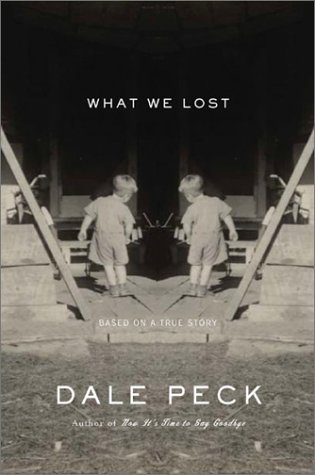
Some people would like us to think that it's all about the literature of literature, but the rest of us would probably rather read books than reviews, even if (or apparently for some, especially if) the pen is wielded by Dale Peck.
Actually I don't even like to go to readings unless the book is the work of a friend, or someone who is as brilliant and provocative as, say, Gore Vidal - or Dale Peck. But here's a recommendation.
Dale is a friend, but he's also a great artist who never lets his readers get too comfortable, so I'm going to be at the Chelsea Barnes & Noble next Thursday at 7 o'clock expecting to be both patted and scratched.
He wrote today, "please come hear me read from 'What We Lost', my new memoir (or, as the Times Magazine would have it, novel)". With that reference and a look at the James Atlas piece itself you can see that, although I believe the book hasn't yet been reviewed outside of the trade publications, the dustup has already begun.
The NYTimes site includes an excerpt of the "memoir", of which this is itself an excerpt:
He must fall asleep then because when he opens his eyes the truck is stopped and the old man is not in the cab. He assumes they've stopped for gas until he sees a gnarled branch above the windshield like a jab of brown lightning and he sits up. To his right a row of leafless trees stretches up the side of a hill and to his left there is a white house, small and rectangular, its tiny second-story windows the shape of dominoes laid on their sides. Before he gets out of the cab he grabs the pillowcase containing his brothers' clothes and the old man's medicine, and the first thing he does is fall flat on his face because he can't feel his feet. Still half asleep, he sits on the crust of snow that covers the ground like stale cake frosting and takes off Jimmy's shoes. The ground is cold and hard beneath his bottom but the bottoms of his feet feel nothing at all, and, teetering, rudderless, he stands up and floats around the truck in his socks, the pillowcase less ballast than slack sail hanging down his back. A pitted two-track driveway runs around the house and up the hill toward a pair of barns and a tall round building that the boy recognizes instinctively as a silo even though it reminds him of a castle tower. At the foot of the silo he sees the old man talking to another man. Like the old man, this stranger is short and thin and has only half a dozen strands of hair slicked flat to his skull, but unlike the old man he stands absolutely still, one hand holding a pitchfork lightly but firmly, tines down, and a cap on the ground between the two men, bottom up like a busker's. The only thing that moves is his head, which shakes every once in a while, back and forth: no. The old man's legs are wobbling and his arms are flapping in the air, and as he wobbles toward them the boy is reminded of a seagull he saw once in the bay. The seagull's legs were trapped in a fishing net, and every time it flapped its wings its orange legs would lift out of the water trailing weed-draped mesh. Over and over the bird's legs had shaken like the old man's with its efforts to free itself but each time, exhausted, it splashed down again.The old man and the stranger are still a good twenty yards away when the old man turns and reels toward the boy. His legs and arms make motions like the spokes of a rimless wheel, and he is shouting,
I won't let her send him away! Not my boy! Not my firstborn son! Not again!
He jerks right past the boy without seeming to see him, his doddering gait half step and half slide on the slick grade, and it seems pure chance that one of his flailing hands catches hold of the door handle, a veritable miracle that he is able to crack it open. The shotgun sound is like an echo of itself in the quiet air, and the boy whips his head from side to side as if he can find the original source. He is in the back of the house now. From this angle he sees that it is actually L-shaped. He can't see the farmhouse across the street, the mountain twenty miles to the south. He sees only a bulbous clump of gray-green evergreens and the tin-domed silo and the two barns and a patch of leafless woods at the top of the hill and then a big field studded with black-and-white and butter-brown cows. When the truck coughs into life one of the cows looks up from whatever thin strands it is pulling from the ground, looks first at the truck and then at the boy and then drops its head again and roots around for more grassgreen grass, the boy can see, even from this distance. It is the middle of January and thin streaks of snow paint zebra stripes on soil hard as a city sidewalk, but the grass that grows from that soil is still green, and by the time the boy turns back to the truck it has backed out of the driveway, narrowly missing what looks like a fencepost with some kind of placard mounted atop it. The truck would have gone into the ditch on the far side of the road had there not been a tree there. Instead something glass breaks, a taillight that is not already broken perhaps, and when the old man shifts into first the boy hears first the transmission's grind and then the glass as it falls onto the road. The truck goes so slowly that had he wanted to the boy could have run after it, could probably have caught it even, even with his numb feet. But he just stands there swaying, watching the truck recede as if one of them, the truck or the boy, is on an ice floe borne away from the shore by a half-frozen current. By the time the truck disappears over the hill the stranger has walked down from the barns and walked on by. There is smoke coming from a chimney on the left wall of the house and the stranger's pitchfork makes a metallic ping each time it strikes the frozen ground.
Feeling floods into the boy's feet then, as if a pot of pasta water had tipped off the stove and spilled over them. He reels, bites back a cry of pain; catches his breath and catches his balance.
Uncle Wallace? he says to the thin brown back retreating down the hill.
The stranger doesn't stop, doesn't turn around.
Get my hat, Dale, he says. At the door he pauses to look the boy up and down, and then he shakes his head one more time. In the failing light his scalp looks white and cold.
Don't forget your shoes, he says, and walks into the house.
For Dale's friends, fans, and the disgruntled too I suppose, the details for this reading and others scheduled across the country in the months ahead are these:
Wednesday, October 6 @ 7
Barnes and Noble Chelsea
675 Sixth Avenue, between 21st and 22nd
New YorkMonday November 10 @ 6:30
Free Library of Philadelphia, Independence Branch
PhiladelphiaTuesday, November 11 @ 7
Olsson's Dupont Circle
Washington, DCTuesday, November 18 @ 7:30
Wordsworth Bookstore
Cambridge, MATuesday, January 6 @ 7
Barbara's Bookstore
ChicagoThursday, January 8 @ 7
Bound to be Read
MinneapolisTuesday, January 13 @ 7:30
Cover Bookstore
(Cherry Creek location)
DenverSaturday, January 17 @ 3
Elliot Bay
SeattleMonday, January 19 @ 7:30
Annie Bloom's Bookstore
Portland, OregonThursday, January 22 @ 7
A Clean, Well-Lighted Place for Books
San FranciscoSunday, January 25 @ 5
Obelisk Bookstore
San DiegoTuesday, January 27 @ 7:30
B&N (West Pico location)
Los AngelesFriday, January 30 @ 7
Book People
AustinTuesday, February 3 @ 7
Rainy Day Books
Kansas City
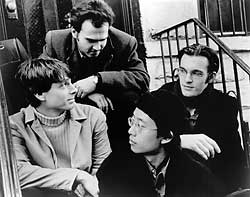
It's a six-hour-long string quartet in one movement, but Morton Feldman's second is both greater and less than the sum of its parts. Greater because it's ultimately much much more than a succession of minimalist pings and rrrr's, and less because hearing it live doesn't seem at all like being kept after school until nine o'clock at night. Even with my own abreviated experience with the work, I now completely understand Jan La Barbara's program note:
For the performers, to play a work like this is to live for a time inside the mind of the composer, to share, for an instant, that artistic sensibility. To listen to such a work is to come close to that experience, the sense of immersion in anothers mind.As part of a series of concert events in New York this weekend called "When Morty Met John...", curated by La Barbara, which describes the extraordinary legacy of the work of Morton Feldman and John Cage and of their personal and musical friendship, the magnificent young Flux Quartet braved Morton Feldman's (yeah, "seminal") 1983 Second Quartet. The performance took place in beautiful new Zankel Hall, which has been blasted out of the bedrock below the much larger Carnegie Hall itself.
OK, Barry and I did actually leave before the piece had run its course, but that was for reasons totally unrelated to its merits. I think I can say that if anyone other than the performers themselves bore any kind of burden tonight it was the working Carnegie Hall staff, which had to hang around until past midnight, and which kept the bar open throughout the evening.
Zankel seems to be having some success in its announced intention of appealing to youth. The crowd this evening looked nothing like that you'd normally find around Lincoln Center, and in fact might have made even the youthful crowds which flock to Columbia University's Miller Theater these days look a little mature - or at least dowdily academic.
The members of Flux rivalled their rapt audience for cuteness, but there was no competition in the honors for heroism. No stops, no stretching, no snacks and above all no bathroom breaks for the four stalwart artists who generously shared their platform with shoeless and barefoot youths, cheeks of tan and pale (and a few of their elders), reclining around them on a couple of kilims and the bare boards themselves.
I haven't seen anything like it since Pandit Pran Nath performed in the sanctuary of the Cathedral of St. John's on acres of oriental carpet over a decade ago. This is my religion.
When everything comes to a halt, about a half hour from now, I would not be surprised if their enthusiastic audience seizes the players and carries them out of the auditorium on their shoulders in triumph. Laurels would be nice.
Morty would be very surprised, and John would be delighted.
Oh yes, there's a CD set, and even a DVD, of the Flux doing this piece. It's available through Mode Records.
More events on Sunday, October 26:
Feldman's "Triadic Memories" at Columbia's Miller Theatre 2:30
Cage's "Music for Carillon" [on Fifth Ave., and free!] at St. Thomas Church 5:15
An evening of Cage at Zankel Hall 7:30
[image from Preview/Musicview]
Wonderful, wonderful theater. Music theater. Opera. Whatever.
No, it's not a "musical". If it were, I would not have been in the audience tonight. It's pure art, especially if art must be both human and accessible to be truly pure.
But don't be afraid. If it's opera, it's what Puccini was for his audience a hundred years ago, not what Puccini represents today.
But it's only here one more evening - this time around.
David Rodwin's "Virtual Motion" can be seen tomorrow, Saturday, at LaMaMa for the last time. Sad enough that the entire run was only three days, sadder still that we didn't see it until tonight and can only write about it now.
I have no idea how Rodwin's art had escaped us until recently, especially since it relates to and is as exciting as the best work of some of our favorite modern theatrical composers, like Robert Ashley, Conrad Cummings, John Moran, and Mikel Rouse.
Rodwin created the music, the book, lyrics and the choreography, and produces, engineered and performs the piece solo. While he has created larger-scale work in the past, including one opera with a cast and crew of thirty, ". . . I knew I needed a simpler, more economical piece if I wanted my work to be seen by a larger, more diverse audience in more places." He's not competing with the Met, since its line of business is essentially that of a well-endowed museum of antiquities. "Virtual Motion" has already delighted people in over a dozen cities, and only some of those would ever be found in a traditional opera house.
In this latest piece the artist is an extraordinarily charismatic and beguiling presence on an almost totally bare stage, both bearing and born on gorgeous waves of live and recorded sounds combined. The music is totally integrated with the theatre in a shared contemporary humanity.
Well damn, the tickets are only $20, and it's only an hour and a half long, with intermission. Don't miss it. Years from now everyone will be talking about the birth at the turn of the century of this "new opera" form, but you shouldn't wait that long to find out what it's all about. Details:
La MaMa E.T.C.
The Annex
74 A East 4th Street
New York, NY 10003
Tickets: 212-352-3101
Tip: There's both audio and visual stuff on his website!
[image from jadelake]
AND THE CITY HAS MADE THE NAME OF HELLENES ATTRIBUTABLE NOT TO ORIGIN BUT TO THE MIND
isocrates, athens, 380 bc
Apropos nothing in particular, I wanted to record this wonderful legend we saw mounted on the wall of the Onassis Cultural Center while passing through the public passage at Olympic Tower this evening.
Last night I wrote that I was scared after hearing that the Secretary of War is going around saying that we're losing the "war on terrorism". Why? It just can't be good news if it's coming from him. I can't expect that he's saying this stuff in order to admit that the whole thing was misconceived in the first place, or because he's about to resign in favor of a replacement which the world might actually survive.
No, I've come to expect the worst from this administration, and I'm still usually unpleasantly surprised. I think Runmmy's current ruminations are all about preparing us all for something really big.
Things aren't going well? The problem is obviously the liberals and the Constitution huggers, those who just aren't taking this war seriously enough. We still have too many freedoms. In fact the world still has too much independence.
Remember that these guys don't expect to ever leave, so this administration would be more than comfortable with a solution which would be some combination of really scary secret police, an elite security staff and perhaps a federal army command, all of them loyal directly to the White House.
Sound familiar? Well, it doesn't have to so redolent of another time and place, but similar dispositions find similar solutions. The necessity for all of this would of course become perfectly clear after the next terrorist event, scheduled or otherwise. We'll hardly notice the imposition of martial law when it comes.
There, I've just outlined the worst-case scenario but I really would like to be pleasantly surprised this time.
If we actually do survive this regime, I hope we will finally be a people without illusions - of blessedness, grandeur, superiority, sanctity, whatever. Enlightenment. Let's go for enlightenment instead of the other stuff.
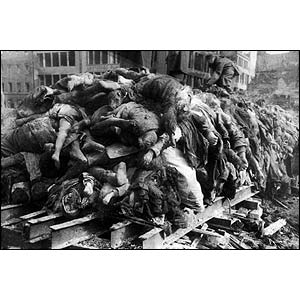
These are thoughts of another war, and the state terrorism practiced by all combatants.
Germans are finally coming out of their bunkers only decades after the firestorms of World War II.
Jörg Friedrich is the author of a new book, Brandstätten (Fire Sites), composed largely of photographs depicting grisly evidence of the civilian casualties which resulted from the allied bombing of Germany's cities during the second world war. Friedrich himself has now become part of a storm of words, nowhere more than in Germany itself. From The Guardian account:
"The bombing left an entire generation traumatised. But it was never discussed. There are Germans whose first recollections are of being hidden by their mothers. They remember cellars and burning human remains," Friedrich told the Guardian in an interview in Berlin last week.The author maintains that the allied bombings, which incidently almost totally destroyed the fabric of 160 medieval cities, was a war crime, in particular the bombs dropped on the militarily insignificant civilian centers of a shattered Germany in the last few months of the war."It is only now that they are coming to terms with what happened."
Around 600,000 German civilians died during the allies' wartime raids on Germany, including 76,000 German children, Friedrich says. In July 1943, during a single night in Hamburg, 45,000 people perished in a vast firestorm.
But in the immediate post-war period, the German victims of British bombing were scarcely mentioned, being overshadowed by the far greater evil of the Holocaust.
Friedrich believes that most Germans refused to discuss what had happened because they regarded the British destruction of their cities as a sort of retribution for the crimes of the Nazi era.
Reaction to Brandstätten has been critical. A reviewer for the Süddeutsche Zeitung, even suggested that it should be thrown in the bin, and a cultural magazine program on German public television dismissed it as a "provocation" that sought to "compare the air war with the Holocaust", a reference which is as much an obstacle for free thought in Germany as it is in the Middle East and elsewhere.
The author had originally planned to produce a book which would include images of the horrors visited by Nazi Germany upon civilians in Poland, The Netherlands Britain and elsewhere. For the images he ultimately used in the book Friedrich combed the dusty archives of cities and towns all over Germany, but the larger scale of the project was blocked by the British. The BBC site reports:
. . . he says the British Public Records Office would not release the kind of horrific images that he found of German victims.Over the Channel too. Odd that Britain still will not permit the release of images of its civilian dead 60 years after the horrors they suffered. A prohibition which might originally have been represented as part of a nation's campaign to maintain a beleagured people's war-time morale just doesn't seem to be defensible today."There were 15,000 deaths in southern British cities between September and December 1940. But you won't see any photos of them," he says.
"The Germans admired the endurance of the Londoners in the Tube stations. But this is the heroic story. If you look at the image of the suffocated grandmother cradling her grandchild in a [German] bunker, there is no heroism."
Keeping pictures like that, and the ones in the book, under wraps may be regarded as a sign of sensitivity - maintaining the dignity of the victims. But could it also produce a censored, sanitised version of history?
"Goebbels forbade these photos of our victims from the German papers," says Mr Friedrich. "In a way, we've obeyed his orders until this day."
Not much has changed. We see no images of Iraqi war dead today, and may never see them. In fact, we don't even see images of our own dead - or even images of the injured. War is kept very clean for those who aren't there.
The Leo Baeck Institute and the Goethe Institute will be presenting a panel discussion on this subject here in New York next Wednesday, October 29, titled "German Civilians as Victims? The Evolution of a Perception".
Participants will include Dr. Frank Bojahr, The Institute for Contemporary History, University of Hamburg; Atina Grossmann, professor of history, Cooper Union; Dr. Volker Hage, journalist for Der Spiegel (Hamburg); and Andreas Huyssen, Villard Professor of German and Comparative Literature, Columbia University. The moderator will be Dr. Frank Mecklenberg, the director of research and chief archivist at the Leo Baeck Institute.
Their announcement includes the following information: The panel discussion is to be preceded by a screening of "The War of the Century-Firestorm" (Der Jahrhundertkrieg-Feuersturm). 2002. Produced by Guido Knopp. Written and directed by Peter Hartl and Annette Tewes. [52 min. In English and German with English subtitles. Courtesy ZDF] The film features historical footage from WWII as well as interviews with German civilians who experienced the massive bombing of such cities as Hamburg, Dresden, Cologne, and Berlin, and with American and British bomber pilots recalling the bombardments.
The film will begin at 6, and the discussion at 7. The location is the Goethe Institute, at 1014 Fifth Avenue, between 82nd and 83rd Streets.
For reservations and information we are asked to call (212) 439-8700.
I'm definitely going to be there. If you plan to go also, please let me know.
[the story and the texts quoted are from The Guardian and BBC News, where images from the book can be found, including that above, of Dresden in 1945]
I'm scared. What's he up to?
I'm afraid I might know the answer, but I don't want to talk about that tonight.
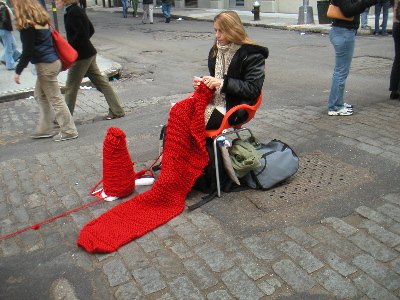
somewhat less than one half of Maria Marinelli's performance at d.u.m.b.o.
Maria Marinelli was also a part of the d.u.m.b.o. festival this past weekend where she was represented by a performance of "Arazzo," one of the four parts of her mixed media project, "IMPERO."
What I saw on Saturday was two women knitting separate long panels or "tapestries" in red yarn of an almost painfully bright hue. They were separated that afternoon by a full block's length of the same skein of thread each was incorporating into her work.
The two pieces being woven by the performers will eventually meet in the center where no more unused thread will remain. In order for one piece to be completed the other one must be destroyed.
in English, the name of the greater project is "EMPIRE." The artist explains, "This metaphor makes visible the paradigm by which every imperialistic culture operates."
"Women's work," indeed!
The rules don't apply to the guy at the top.
It's all so absurd, from top to bottom, but there's a reason we're so attracted to the details.
Let's see, Roman Catholic Church rules require bishops to retire at the age of 75. The pope is historically and essentially the chief bishop, by virtue of his office as Bishop of Rome. That's the last position held by the disciple in whose charge it's reputed founder, Jesus, is said to have placed the organization before, or after, his early death. The current Bishop of Rome is 83.
Church rules also forbid cardinals (an honorific title given certain bishops) who are above 79 years of age from participating in the centuries-old tradition of electing one of their number to the office of pope. The current occupant of that office is himself 83 years old.
Wojtyla would have had to retire by now were he still only a bishop, and he would be ineligible to vote were he still only a cardinal, but in spite of very obvious deterioration he has not submitted his resignation, shows no inclination of doing so, and since reaching the age of 80 he (or perhaps others using his authority) has appointed a total of 74 cardinals on two occasions.
We are encouraged to believe that this pope is not like other mortals, not even like (his) bishops and (his) cardinals, who in truth actually function only as lackies and decorative tassels for an absolute, super-national monarch, not to say a fanatical cultist and tyrant.
Incidently, the current pope has exceeded rules promulgated by his predecessor, and which he himself has reaffirmed, that limit the size of the electoral conclave to 120. Wojtyla has increased the number of eligible voters in the College of Cardinals to 135, but has not changed the conclave voting rules, suggesting there may be charges ["cardinal" or secondary] of voting irregularities should he die soon. Even if he has personally picked all but 5 of the 135 electors, largely on the basis of their conservative or reactionary politics, the next election might be more exciting than Florida or california.
Except as entertainment or as a regular and delicious treat for a history buff, none of this would be of any interest to me or most of the world if what happens to Catholics did not impact us all. Unfortunately it very much does. The disaster that is the Roman Catholic hierarchy, and in fact the entire business model, is also a disaster for the world.
There was plenty of art - and entertainment [is that a problem?] - at the d.u.m.b.o. art under the bridge festival this past weekend even for those who didn't make it into the many open artists' studios. Much of it was about real estate. All of the very best outside stuff was conceptual.
One of my favorites was "Endangered Species," the work of Michelle Handelman and Vincent Baker, located under an arch of the neighborhood's eponymous Bridge.

Behind the heavy green-painted corrugated metal wall, and really down under manhattan bridge overpass was a wonderful sound installation of the cries of some very angry elephants. The curiosity quotient was strong, but nothing was actually visible beyond the barrier.
A small placque in the lower right of the picture identified the artists, and added:
harlem, soho, tribeca, the lower east side....we haven't forgotten.
PLEASE DO PUT HANDS IN GATE

[but surely more than two]
At first I just wanted to post something about the latest horrors being visited upon Palestinians caught between the lines (the Green Line and the new Apartheid Wall line), but I didn't know where to begin - or end - such a story.
In the meantime I had found my way to the site of The Electronic Intifada, and I there I found my story. I suppose it's a cop-out in a way, because it avoids describing individual suffering in order to talk about how all the bad stuff might end. But maybe that's a good thing.
An articulate argument remarkable for its absence of rancor, blame or fury, advanced by Ali Abunimah, founder of the EI, outlines the case for the "one state" solution to the sufferings of Israelis and Palestinians alike. The article appeared on their website last week.
Abunimah begins by observing, ". . . it is inescapable now that what already exists is in effect one state: Israel, in which half the population -- the Palestinians -- have second-class rights or no rights at all, not even citizenship." While he apparently writes as a Palestinian, and directs his words primarily to Palestinans, I wasn't aware of any parochialism while I was reading. The words are for everyone, especially since the entire world is horribly impacted by this, yes, fundamentally parochial conflict. Remarkably, in the end the "one state" argument is also even more practical than idealistic.
It is the moment, therefore, for us to declare the era of partition over and commit to a moral, just and realisable vision in which Israelis and Palestinians build a future as partners in a single state which guarantees freedom, equality and cultural self-determination to all its citizens. Refusing to make this choice now means effectively agreeing to the endless bloodshed and extremism offered by Israel's political-military establishment and Hamas.Not part of the essay, but built on a truth understood by jews and arabs throughout the region, is the argument from demographics. The Palestinians will win the population race in the end, and an Israeli state defined by religion or race and controlled by a minority will have burdens which make today's look like small nuisances.. . . .
The burden to persuade Israelis lies largely with Palestinians, who while demanding equal rights and an end to the Jewish Israeli monopoly on power, must hold out a future in which the two communities express their identities as equals rooted by right and history in the same land.
This is undoubtedly an unfair burden, but it is a fact that oppressed groups must often show their oppressors a way out of the tunnel they have dug. This was true in South Africa, where even in the darkest days of apartheid, the African National Congress under Nelson Mandela offered white South Africans a future of reconciliation, not revenge. As in South Africa, a truth and reconciliation process can help both peoples overcome the pain of the past even as they build a just future together.
Israeli and Palestinian supporters of a one-state solution must build a new movement. This partnership must work to translate the vast international sympathy for the Palestinian cause into active support for the transformation -- with international assistance and guarantees -- of Israel and the Occupied Territories into a democracy for all its inhabitants. It must be a movement that builds political and moral power through non-violent resistance and civil disobedience, and mobilizes the widest possible base. Only through such a movement, I am convinced, shall we create peace in our lifetimes.
But it doesn't have to ahppen that way. The whole world could be an early winner if the "one state" approach described by Ali Abunimah were not absolute anathema for men with small minds and big clubs.
The particulars of the latest news from Israel/Palestine, especially as they might describe what is happening to Palestinians innocent of violence, are both too complex and too horrible to outline here, but they remain virtually unreported in the U.S. In the past I have used this space to give voices to dear and trusted friends who were in the Middle East, but it cannot really substitute for what is missing from the American media.
For that we all have to do our own searches. In addition to the website which produced the text I excerpted above, my friend and Middle East peace veteran Steve suggested several others when I asked where someone who was interested might get general summaries. I have listed them all below. Not surprisingly, and appropriately, they are not always of one voice.
The Electronic Intifada
Gush Shalom
B'TSELEM
Stop the Wall
UPDATE: For more on the few English-language websites which cover Palestinian issues specifically, go to this USC journalism site.
[image from The Electronic Intifada]
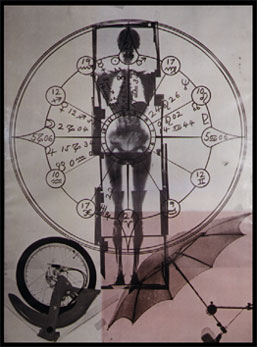
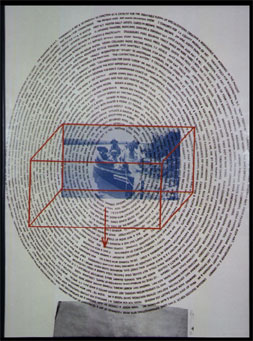
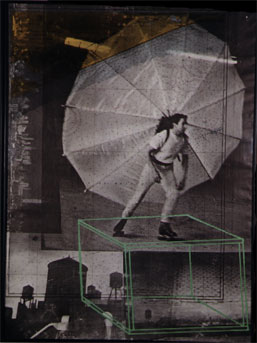
ROBERT RAUSCHENBERG, Autobiography, 1968
The three panels of this large offset lithograph by Robert Rauschenberg from 1968 titled Autobiography are displayed vertically and exceed 16 feet in height. They were printed with the type of press used to make commercial billboards. The three panels are layered with seemingly disparate images that, on closer examination, are probably thematically grouped. The top panel features a composite X-ray of Rauschenberg's own body superimposed with the artist's astrological chart, suggesting both the present and the future. The center panel deals with the artist's past; at its center is a photosilkscreen of the artist as a two-year-old boy with his parents boating on a bayou near his home in Port Arthur, Texas. Surrounding this photosilkscreen is a labyrinthine oval of handwritten text narrating events in the artist's life. The lower panel seems to address artistic creativity and is dominated by an enlarged photograph of Rauschenberg during his 1963 performance "Pelican," in which he wears rollerskates and a parachute on a wooden armature harnessed to his back. Rauschenberg was one of several performers and he also choreographed this performance. This particular image suggests both movement and flight, which are themes carried through in Rauschenberg's art and life.Autobiography's visual overlay of seemingly discrete and unrelated appropriated images is quintessential Rauschenberg, but the emphasis on personal or autobiographical subject matter is not. The vision underlying Rauschenberg's aesthetic has often been interpreted to mean that meaning itself is created through accidental, improvised, intuited, and even illogical juxtapositions and associations. In that sense, what Rauschenberg offers us in Autobiography are images he had at hand but they are also images of personal significance to him. Rauschenberg once stated: "I don't want my personality to come out through the piece . . . I want my [work] to be [a] reflection of life . . . your self-visualization is a reflection of your surroundings."
[image and text from Philadelphia Art Alliance]
We went to a performance at BAM of Charles Mee's "bobrauschenbergamerica" tonight. Barry and I both found that like much of this wonderful man's work, which I've now been enjoying for several decades, this evening of theater, which was created and performed by SITI Company and directed by Anne Bogart, took a while to come together. Barry thinks it's Mee's plan, and I think I agree.
When it was finally assembled it was magnificent.
I haven't seen a decent review in the media, so I won't link to any tonight, and I don't have the nerve to try one myself, but I will at least say that I was eventually overcome by the piece' sweet sincerity and delighted with its amazing sense of place. In a dramatic account of the world which produced Robert Rauschenberg's art that would seem to mean a mission was accomplished.
But it didn't come easily. It was about halfway through an evening punched through with scattershot American vignettes, at once both perverse and ordinary, that I began to cry. The tears were for the sometime beauty and goodness of this people and for how much has been lost in recent decades, but they were also tears of joy.
Admittedly the play and its performance basically ignored the ugliness and the evil that was also a part of what we regard as the simpler, mid-century America, and it's assignment was not to dwell on how much the bad stuff remains or has multiplied today. Still, when the stage was emptied tonight, only warmth and especially hope remained behind. Amazingly, there was no sugar on the floor of the theater, but there was also not a wit of jingoism in the air, no rhetoric of any stripe. Quite an accomplishment that, especially these days.
The most moving moment in the theater this evening was an oration whose conceit is that it begins by appearing to be an actor's address to the audience about this play, but it very soon becomes clear that it is much more. Barney O'Hanlon played Carl, who speaks to the museum visitors immediately after his assassination.
What follows is the complete oration, delivered near the end of the evening, a beautiful ode to art and artists in general, and the art and the artists of this strange people in particular.
[Carl, who has been lying on the stage dead, sits up and gives a speech welcoming everyone to an art opening, while we hear cement mixers, pounding, banging, clanking, sawing.]OK.
How we put the show together.
First, I want to welcome everyone
I'm glad you could all come tonight.
We don't often get to do a show like this
where we can just put on whatever we like
figure OK what the hell
lets just do whatever we feel like
and hope you'll enjoy it.
I often feel those of us who are in the museum world
are particularly blessed.
Because we get to explore our feelings
whatever they may be
that's a sort of freedom.
You know, that's how it is to deal with art
because art is made in the freedom of the imagination
with no rules
it's the only human activity like that
where it can do no one any harm
so it is possible to be completely free
and see what it may be that people think and feel
when they are completely free
in a way, what it is to be human when a human being is free
and so art lets us practice freedom
and helps us know what it is to be free
and so what it is to be human.But, still, it often seems to me almost miraculous
how we can put things here in the museum
and ordinary folks
my mom and dad and my own neighbors
and I myself
will come to see things
sometimes things that I myself find completely incomprehensible
and really offensive
people will come to our museum
and think: oh, that's interesting
or, oh, that's stupid
but they don't really hold it against the show
they just move on and look at something else and think
oh that's cool.
And I wonder:
how do we get away with that?
And I think well, we are a free people
that's why
and we understand that
in a way maybe other people in the world don't
we like an adventure
often we might think
well, that's a piece of junk
but that's how this fellow sees the world
and there's a certain pleasure in seeing things from his point of view
we are a patient people
no matter what you hear people say
and a tolerant people
and a fearless, open people
that's how it is for usI think that's how it is to be an American.
We're all unique.
It's a precious thing to compare ourselves to nothing else.
This is my working attitude.
I don't feel shame in my joy.[He looks confused.]
I started out here knowing what I meant to say
and now I have to say
I don't know what I said.But I'd just like to welcome you
and let you know
we're all glad to be here with you tonight
to share this with you
and we hope you have a swell evening.
[The text can be found on Charles Mee's own wonderful site, which amazingly and very generously makes all of his work available to the public]
I haven't seen this anywhere else yet, so it must be an April fool's joke. But, wait, this is October!
These people are definitely going to get us all killed!
Defense Secretary Donald H. Rumsfeld and the chairman of the Joint Chiefs of Staff are defending a new deputy undersecretary of defense "who has reportedly cast the war on terror" in religious terms.Mine's bigger than yours? He really said that?Lt. Gen. William G. Boykin, whose promotion and appointment was confirmed by the Senate in June, has said publicly that he sees the war on terrorism as a clash between Judeo-Christian values and Satan, the Los Angeles Times reported Thursday.
Appearing in dress uniform before a religious group in Oregon in June, Boykin said Islamic extremists hate the United States "because we're a Christian nation, because our foundation and our roots are Judeo-Christians. ... And the enemy is a guy named Satan."
. . . .
Discussing a U.S. Army battle against a Muslim warlord in Somalia in 1993, Boykin told one audience, "I knew my god was bigger than his. I knew that my god was a real god and his was an idol."
Hey, this just in, spotted here at one in the morning. The NYTimes has the story in Friday's editions. It's there that we finally learn how Bush became president.
In another speech, General Boykin said God had selected George W. Bush as president. "Why is this man in the White House?" he asked. "The majority of Americans did not vote for him. Why is he there? And I tell you this morning that he's in the White House because God put him there for a time such as this."The Times tells us that he was he was wearing his military uniform and was speaking at religious functions each time he is reported to have delivered the messages now being reported.
I guess they're no longer trying to hide the nature of the regime, but we can't expect that to help turn off many Americans.
UPDATE Thanks to Cursor today, we're now reminded that back in April The Nation had already reported on the nature of Boykin's magnificent obsession, but his appointment was still easily approved by Congress in June.]
FOLLOW UP on "two shades of green"
Yesterday it was an article in New York magazine which triggered my despairing post about developments at the World Trade Center site. Today it's the New York Times. Why are they getting upset only now, when it's almost certainly too late to stop the grinding gears of business-as-too-usual as we stand on the side awaiting the arrival of banality-and-much-worse?
The first paragraph of the following quote appears as the introduction to the piece in the NYTimes print edition this morning, but is curiously missing on the website, depriving David Dunlap's text of much of its sense for electronic readers, and even producing quite a different spin.
The faces staring upin horror that morning from the streets of Lower Manhattan were every color. So were the faces staring out from the "missing" fliers around the city. But the hands drawing the plans for the new World Trade Center are almost all white.The New York architect J. Max Bond Jr., whom the paper describes as "both black and an éminence grise in architectural circles," advocates a process which would include not just minority voices but those of poets, philosophers and artists.What may have been lost in the transition are voices; voices that might have questioned basic assumptions about a program in which skyscraping commercial development is to accompany the memorial, cultural and open spaces; voices that might have asked whether a public domain under tight control is truly public.
He also takes issue with proposals to put pseudo public spaces in private hands, [a development which has increasingly burdened New York over the last few decades], and suggests that opening participation in decision making to the larger community would have exposed such follies.
Many designs for the site called for gardens, shops, museums, restaurants and viewing platforms on high floors or at the top of buildings. But Mr. Bond said any space under strict scrutiny was not universally welcoming.And on the subject of skyscraper superlatives Bond's comments show the full extent of his modern humanism:"It's always been difficult for young blacks, for young Hispanics, for anyone who looks aberrant to get access to the upper realms of Wall Street towers," he said. "For a city of immigrants, the public realm is more than ever now the street. If I'm a Dominican kid and my immigration papers are not quite right, I'll never go up there because I'll never dare show my fake ID.
"All these public spaces are going to be like shopping malls: privately controlled. You won't be able to wear a T-shirt that says, `Down with Ashcroft' because that will be viewed as hostile or threatening."
"There's a macho thing that keeps coming out: we should build a building that tall to show them," he said. "Not everyone shares that sensibility. It's a particularly male, Western sensibility.Including, obviously, the issue of who really retains the power."I'm not saying people of color are wiser. But women, people of color, gays, immigrants have all had to look at themselves. They have experienced the underside of society in a much more profound way.
"Architecture inevitably involves all the larger issues of society."
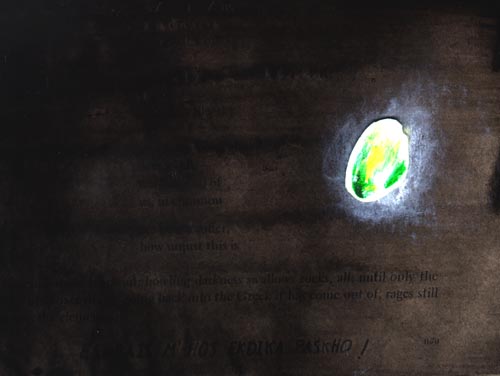
Tim Rollins and K.O.S., untitled, from Prometheus Bound, 1997
[image not in the show at Art Resources Transfer]
It's a gorgeous mini-retrospective, or, better, a retrospective of the smaller-scale parts of 20 years of collaboration. Tim Rollins's work with the Kids of Survival (K.O.S.), studies in this case, mostly on paper alone, are now being shown in three rooms at the Art Resources Transfer (A.R.T.) space in Chelsea until November 15.
What for me had until now been available only in scattered glimpses of separate projects is now assembled in what admittedly is still only a tantalizing suggestion of the larger, finished pieces in each. But what a treat these suggestions are!
Each of the 40 works is inspired by and is physically lying upon the text of a major literary work or musical composition. Art has seldom been so literate, especially if we remember that the Tim Rollins and K.O.S. collective is as much about teaching as it is about painting and drawing.
The artists' chronology begins with a 1983 delicate sketch of Jesse Owens on a page of Mein Kampf. Chapter: "Race." It ends with Bush II in 2003, drawn as a two-legged squirel stretched across a page of Animal Farm which includes the creatures' Seven Commandments, which begin with, "1. Whatever goes upon two legs is an enemy."
In betwen there is Aeschylus, Ray Bradbury, Dante, Hawthorne, Haydn, Kafka, Stoker, Strauss, Wells and dozens of others, all of them beautifully illustrated and intelligently and powerfully amplified in the process. It's a great treat, and a moving encounter on any level.
A.R.T. is located at 210 11th Avenue, between 24th and 25th Streets, on the fourth floor, and open Tuesday though Saturday from 11 until 6. 212-691-5956
[image from Dia Art Foundation]
Happy Marriage Protection Week! Yup, it's finally arrived. Our chief theocrat has decreed that this very week be so honored, in lieu of the threat posed by fags and lezzies.
I don't think I've even alluded to the subject of marriage on this site before. It just doesn't interest me. In fact it normally disgusts me. Maybe it's mostly an aesthetic thing. But this is just ridiculous, and I just can't keep out of it. I'm still no fan of marriage in any form, and I suspect I'm not alone in believing that the real threat has always been to the unmarried. That has obviously not changed.
Still, Marc Morford is pretty persuasive as he nears the end of his tribute to Simpleton's proclamation with these generous thoughts on the subject, brilliantly articulated:
Let's make this perfectly clear: Marriage does not need protection. Traditional marriage does not need any forcible recommitment by right-wing Christian zealots who try to force everyone into little shiny happy heterosexual SUV-sized boxes of sameness and sanctimony and bad rented tuxedos and engraved gravy boats.In fact, much like the church and the concept of "family" and Jenna Bush, marriage needs to be busted wide open. Marriage needs to be allowed to move and progress and dance as the culture moves, as consciousness progresses, as times and mores change, recognizing along the way that what might have been some toxic nuclear-family ideal in 1953 holds nearly zero relevance today, and in fact only makes us more uptight and rigid and confused.
Marriage needs to be tickled until it screams. Marriage needs to be stripped down and sprayed with whipped cream and licked all over. Marriage needs to be blown apart with the dynamite of new possibility and put back together again in ten thousand different kaleidoscopic configurations, each one encouraged and celebrated and applauded, even those that don't involve ridiculously expensive cakes and tepid church ceremonies and the bride zonked on Valium as the groom slams another scotch to calm his nerves.
This is the only way. Evolve or die, honey. Because it's exactly when you try to force-fit love's modern, ever-evolving mutations into archaic, increasingly bitter boxes of ideology and Right wing-approved blandness and sactimony that the culture suffers most. Legislating love is never the answer. Hey, just ask your neighborhood Catholic priest.
Kelly and money.
The results are in, ladies and gentlemen.
Forget two years of agony and hopes for resolution, two years of arguments and competitions, two years of talk and spin, we now have an answer. The World Trade Center site is going to look nothing like what we wanted, what we were told we would get, what we should have.
Liebeskind's design, whatever its value, is dead, even if Liebeskind, complicit in his own defeat, is still there for cover (and surely a fat paycheck). The public be damned, money is talking, and the conversation isn't pretty or smart, because Larry Silverstein is in charge.
We're going to have to suffer years, actually decades, of construction messes in order to end up saddled with a huge affront, the usual New York contemporary corporate high-rise junk. There is no coherent plan, no monumental architecture, no humanity, no spirit, and not even a cold aesthetic geometry survives.
Last week I was once again struck by the absolute rightness of Ellsworth Kelly's magnificent WTC site proposal in his 'Ground Zero', when I visited the Whitney Museum, which is currently displaying his "red green blue work." The simple newsheet collage he sent to the NYTimes architectural critic Herbert Muschamp early in September has been donated to the Museum. It hangs, modestly-framed and almost invisible, near the elevators in the lobby.
Sublime. It's what we need right now. We can build towers on other lots. There's nothing to keep us from getting Kelly's green, except the money that talks.
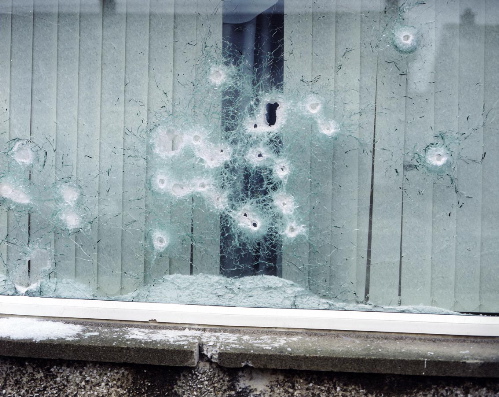
Phil Collins, holiday in someone else's misery II 2003

Phil Collins, abbas amini 2003
These are two more images from the current show at Maccarone Inc.
The NYTimes is talking about religion this week, in articles on two successive days.
You needn't read all of what occupies more than two full pages in the print edition to realize that the conclusion is basically religion is down in happy countries and up elsewhere. Note to Americans: Faith is an expanding industry here.
Europe has all but abandoned religion. In the United States it shapes politics and society and indeed our view of the world. In the third world, Christianity in particular is growing by leaps and bounds.
The article explains that the secularization of Europe and the increasing importance of religion in the U.S. is one of the forces pushing the continents apart.
Americans are widely regarded as more comfortable with notions of good and evil, right and wrong, than Europeans, who often see such views as reckless.Christianity is booming in Nigeria and elsewhere in Africa.In France, which is predominantly Catholic but emphatically secular, about one in 20 people attends a religious service every week, compared with about one in three in the United States.
"What's interesting isn't that there are fewer people in church," said the Rev. Jean François Bordarier of Lille, in northern France, "but that there are any at all."
Here nobody, it seems, can afford not to pray.I knew we need help, but more religion in America can only mean disaster. From a professor of religious studies:"In countries where everything is very O.K., where they take care of their citizenry, people are very lethargic when it comes to religion and God," said Oluwayemisi Ojuolape, 27, a lawyer in Lagos, who attended this all-night vigil, called Holy Ghost Service. "They are not encouraged to ask for any help. They seem to have all of it."
"I've been struck by the way in which religion now serves to underpin the divergence between Europe and the United States, and where I particularly saw that over the last year or two was in attitudes about the Middle East," said Philip Jenkins. Dr. Jenkins is a British scholar who teaches history and religious studies in the United States and wrote "The Next Christendom" (2002), about changing patterns of Christian worship around the world.Me too.
"Americans still take biblical and religious arguments very seriously, and therefore give a credence to the Zionist project that Europeans don't," Dr. Jenkins said.He said that for many Americans, the frequency with which President Bush invoked morality and religion in talking about the fight against terrorism was neither striking nor discomfiting. "But in Europe," he added, "they think he must be a religious nut."
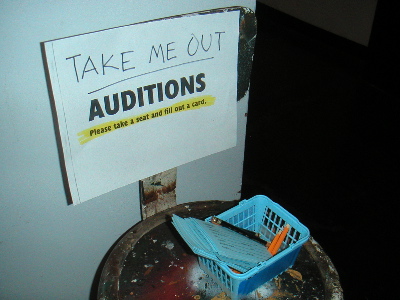
Public Theatre hallway, Monday afternoon
Kucinich. Anthing else is a compromise, or a disaster - almost all of it under corporate labels - and unfortuantely we've already tried that.
Dennis J. Kucinich, the four-term Ohio Congressman, officially announced his longshot candidacy for president on Monday, laying out a populist platform of nonviolence, universal health care, workers rights and increased spending for education.He spoke in Cleveland City Council chambers, where he had begun his political career at the age of 24.
Mr. Kucinich basked in the favorite-son status with a childlike smile on his face before offering a list of progressive agenda items from a speech scribbled on sheets of paper from white and yellow legal pads.But it won't be progressive if he loses. And can the media stop patronizing progressives? How is it smart always to go with the commercially-packaged product?He said he would return to bilateral trade by revoking United States participation in Nafta and the World Trade Organization, repeal the antiterrorism legislation called the USA Patriot Act, create a universal health care system, establish universal prekindergarten schooling and create a cabinet-level Department of Peace that would bring the Rev. Dr. Martin Luther King Jr.'s principles of nonviolence into government.

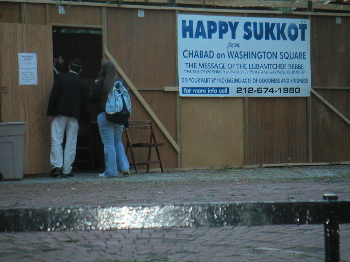
I don't get it. Who've they paid off? I walked into Washington Square Park this afternoon because I wanted to know why a construction shed had been installed at the edge of the central fountain area. It wasn't a construction shed. Instead it was the ugliest sukkah I've ever seen, and except for a door facing the fountain plaza it was fully-enclosed with plywood on all four sides. There is a hinged door and it can be locked.
A large sign along the side assigned to the door read in part:
THE MESSAGE OF THE LUBAVITCHER REBBEI spotted at least a half dozen young uniformed touts trying to persuade people who identified themselves as Jews to enter the plywood box. Many did. I was asked if I were a Jew. He was very cute, but I politely replied in the negative.
THE ERA OF MOSHIACH (A WORLD OF PEACE AND GDLINESS) IS UPON US
Amazingly, the whole thing is the work of a very specific sectarian organization which proselytizes among Jews. It's not even close to a creche, an image of Shiva or a statue of Buddha, regardless of the lack of merit for the erection of those symbols on public property.
Because I've always thought of sukkot as the most charming of Jewish holidays, I found this cult's rude Washington Square incursion to be an assault to the senses as well as a violation of the fragile principle of a secular state. This is a New York City public park. Sukkot is a religious holiday. The sukkah is a religious symbol, if not actually a place of worship. It is also a structure. The moshiach, or messiah, is a religious concept. The city of New York should not be in the business of "gdliness." I felt very uncomfortable in the park today.
This is a bad thing, and you don't have to be an aesthete or an atheist to understand that.

Christofo Colombo
Mysterious Biography
Christofo Colombo was a hungry man,
hunted himself halfway round the world;
he began poor, panhandled, ended in jail,
Christofo so hungry, Christofo so poor,
Christofo in the chilly, steel bracelets,
honorable, distinguished Christofo Colombo.
Carl Sandberg
[image from John Mitchell]

Phil Collins, enduring freedom 2002
[the image is not part of the current NY show]

Phil Collins, fov evevr 2003
[image currently at Maccarone Inc.]
I've been very bad. Barry and I went to the Phil Collins show at Maccarone Inc. last Sunday, and I'm only getting around to writing about it a week later.
It's a wonderful, intelligent gallery and an exciting space, particularly right for this aesthetic. Rough. No, tough, but with much warmth. Collins's work is breathtaking, and its presence in these rooms is just right. We arrived on a beautiful fall afternoon, in the full light of day. I hope you schedule something similar. You'll be on vibrant eastern Canal Street, just before the entrance to the Manhattan Bridge.
Collins's images are incredibly powerful even if you're ignorant of their context. The context, at least for some of the work in this show, that dealing with asylum-seekers, refugees and the displaced, is provided by an incredible video running on the ground floor. I had gotten all of the way up the stairs before Angela told us that the raw storefront space below was now part of the gallery. We headed back down to view an extended, much-violated and frightened Kosovo family being shuffled around a large couch for a group photograph, but not before we watched one boy, a beautiful injured teenager who was unable to remember much of anything about his assault, being questioned about the scars he shyly revealed to the camera.
On the third floor are intimate but incredibly strong images of people who answered a newspaper advertisement asking for people who would agree to strip for his camera in a hotel room rented for the purpose. Collins is from Northern Ireland and has lived in parts of the former Yugoslavvia and other parts of the world which have suffered from ethnic violence. The hotel was in Basque San Sebastian. The results apparently surprised even the artist.
Collins's larger body of work is about the impact of social and political conflicts on human beings everywhere in the world, and it's also about his own relationship to his subjects. He is able to remove himself from the people he photographs only far enough to complete his record. He remains involved, and we are drawn in along with him, never to leave altogether.
Only after we were already home did I think about the fact that we had no idea what the photographs were selling for. In fact, were they actually for sale? It had not occurred to either of us that what we had seen might have any relationship to commerce. I still haven't asked, but I'll be going back.
Visit Maccarone and Collin's work. I think you still have all of this month. Sorry, the website isn't finished yet. The gallery, located at 45 Canal Street, near Chrystie, is open Wednesday through Sunday from noon until 6. You'll see three floors of an old mercantile building and a great artist's humanity - and much of the greater humanity, including the inhuman parts.
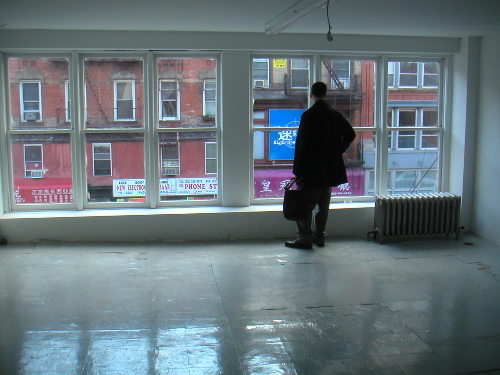
From Maccarone's third floor, Barry included
[Enduring Freedom image from Kerlin Gallery, Missing from fashionoffice]

Nineteenth-century German ceramic doll
He made his own path.
John Darcy Noble, noted eccentric and expert on playthings of all ages, a leading museum curator, theorist and collector and creator of toys as amusements and as art, died in Vista, California, September 21 at the age of 80. He leaves his companion of 44 years, Robert M. Clement.
He was born the son of a blacksmith in Brockley, a town outside London which he captivatingly described as Dickensian in character. He studied art, he painted and he produced theater props and costumes. He collected and sold antiques. He was a lifelong friend of Quentin Crisp, whom he first met at Goldsmith's College of Art.
In London during the 40's and 50's Noble cultivated friendships with the avant-garde, but his career only became defined fully when, during a long summer holiday on Fire Island in 1960 [This really is a fairy tale.], he made personal contacts which soon resulted in the creation of the totally new position of curator of toys at the Museum of the City of New York. [Barry just whispered something about "velvet mafia."] He retired in 1985.
Noble made us realize toys are at least as important as they are fun. Historically, "toys weren't bought by children," he observed.
Mr. Noble more than doubled the museum's toy and doll collection. He championed the emerging contemporary artists who were making dolls, with exhibitions called "Faerieland in New York" and "Flights of Fancy."Mr. Noble was consecrated a bishop in the Church of the Beloved Disciple in 1980, a Manhattan church created to reach out to the gay and lesbian community. He and Mr. Clement, who is also a bishop, were in the process of founding another branch of the church in Los Angeles.
Phyllis Magidson, curator of costumes and textiles at the City Museum, recalled Mr. Noble as "a pixilated man as in whimsy and playfulness," and chuckled at the memory of one of his favorite lecture topics. In it, he pooh-poohed the sanctity of the pristine preservation of dolls.
The lecture's title: "Go Ahead and Re-dress It, Honey; No One Will Ever Know."

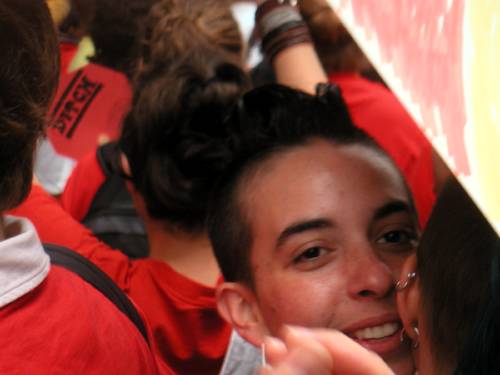
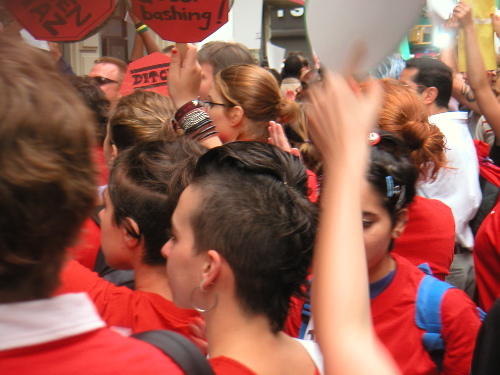
DITCHs on Astor Place September 8th
We spotted the elusive DITCH outside of Harvey Milk High School early in September. The acronym represents the "Dykes' International Terrorist Conspiracy from Hell." the precise name still not settled just one month ago, when we inquired.
Tomorrow afternoon the new lesbian activist group will unveil itself officially, in Lefty-historic Union Square, with a sassy street party, dubbed "Double D," expected to go from 1 to 4.
Time Out New York has a feature article on the group in its Gay & Lesbian section this week, but the magazine is too cheap to put anything on their website, so go borrow or steal it for the picture and the text.
Continuing direct action in the wonderful tradition of the Lesbian Avengers, with continuity provided by the fabulous Maxine Wolf.
"There are a million things that I'm enraged about," declares Marisa Ragonese, 25, before elaborating. "People have elected a right-wing lunatic. Thre are countless issues of race and class dicrimination," she says. "And I still can't walk outside my house without being harassed for being a woman."Gosh, I hope they can get Max to start using email - even if she won't get herself a website!

Shirin Ebadi arriving at a news conference in Paris today
In a brilliant decision by the committee in Oslo, the Nobel Peace Prize has been awarded to an Iranian lawyer and former judge, Shirin Ebadi, who becomes the first Muslim woman to win the award.
The Norwegian Nobel Committee praised Ebadi -- Iran's first female judge before the 1979 Islamic revolution forced her to step down in favor of men -- for battling to defend the rights of women and children.Her most serious rival in the competition, Karol Wojtyla, the Catholic monarch, must have been greatly disappointed, and sour grapes were served in Poland and the Vatican today.. . . .
The five-member committee said Ebadi, jailed several times during her career and once branded a threat to the Islamic system, was a "sound professional" and a "courageous person" who had "never heeded threats to her own safety."
"We hope that the prize will be an inspiration for all those who struggle for human rights and democracy in her country, in the Muslim world, and in all countries where the fight for human rights needs inspiration and support," the committee said.
Ebadi, 56, won from a record field of 165 candidates including Pope John Paul and ex-Czech President Vaclav Havel. Many hailed the award but former Polish President Lech Walesa, the 1983 Nobel winner, said the Polish pope should have won.For more on only one enormously important part of Wojtyla's record, see bloggy.. . . .
A prize to the ailing pope or to Havel could have been too much like a long-service award when Alfred Nobel, the Swedish founder of the awards, said he wanted to inspire "dreamers."
Many researchers say that the pope's opposition to birth control, pre-marital sex, homosexuality and female priests seemed intolerant to many Norwegians, especially women, despite a 25-year-reign devoted to peace and religious reconciliation [on his own terms].
Three of the five Nobel committee members are women. One Vatican official sniffed: "I thought this was a peace prize and not a prize in sexual ethics."
. . . .
Walesa slammed the committee for passing over the pope. "I have nothing against this lady, but if there is anyone alive who deserves this year's Nobel Peace Prize it is the Holy Father," he said.
[image from REUTERS/John Schults]
No, I haven't posted a thing on that subject today. In fact I've never posted anything on that subject. I find it unspeakable and in fact entirely beyond words. Although it's a luxury in which I will almost certainly regret indulging myself, I've decided I can pretend it just didn't happen.
Good night.
Stealth disco!
Via the newsletter from Mark Morford today, one of the most delightful links I've seen all year. Almost makes me wish I was back at work in an office. No, not my old office, but one more like this one:
And they're too stupid to be able to carry it off - unless we're equally stupid.
Bush says we may never know who did it, but in the meantime the White House lawyers are going over every document before it is handed over to the Justice Department (which is itself under White House authority) pursuant to a federal criminal investigation requested by the CIA.
I have no idea whether we'll find out who the leaker is," Bush told reporters after he met with his Cabinet. "I'd like to. I want to know the truth."Two weeks?
WASHINGTON, Oct. 7 White House lawyers will spend up to two weeks screening responses turned in by roughly 2,000 staff members asked what they know, if anything, about the unauthorized disclosure of an undercover CIA officers identity.The disclosure of criminal activity was originally made months before any investigation was initiated, and even once the Justice Department finally had to announce its interest it did not immediately order the White House to preserve potentially relevant documents. The Department, in originally notifying the White House of the probe on the night of Monday, September 29, told its counsel he could wait until Tuesday morning to instruct the White House staff to preserve records. Ten or so very useful hours were lost. New York's Senator Schumer:
"Every seasoned prosecutor will tell you that the first thing that must be done when an investigation begins is the preservation of evidence and documents."Oy veh!
But we'll get the documents, and Bush will fall in the end - unless he makes another war.

Orchard Street market on Sunday
Did Dick Cheney's secret energy policy task force meetings discuss an Iraq war? Former NJ governor James J. Florio suggests the possibility. Sure would help explain why the administration continues to fight so hard to keep the meeting records from the public.
It is hard to imagine that the subject of Iraq and oil did not come up. Any specific discussion that just happened to preview our subsequent course of action in Iraq would be problematic for the president. What did he know and when did he know it? Pre-emptive war for reasons hidden from the public would be a historic first and a dangerous precedent.
I've located the complete statement I described yesterday in which Bush announced that "Free nations don't develop weapons of mass destruction." Silly us. After all the fuss it appears right on the White House website, in the section, "Jobs & Economic Growth."
The context is described as remarks delivered at the Midwest Airlines Center in Milwaukee yesterday morning. This is the entire paragraph:
We have more work to do in Iraq. A free Iraq, a peaceful Iraq will help change an area of the world that needs peace and freedom. A peaceful Iraq and a free Iraq is part of our campaign to rid the world of terror. And that's why the thugs in Iraq still resist us, because they can't stand the thought of free societies. They understand what freedom means. See, free nations are peaceful nations. Free nations don't attack each other. Free nations don't develop weapons of mass destruction. [my italics] There will be a free and peaceful Iraq. What's taking place in Iraq is the evolution of a society, to be democratic in nation -- nature, a society in which the people are better off.So there it is, boys and girls.
It's so refreshing to get a comment like the one at the bottom of this post which arrived today from "old Europe," after a couple of weeks of being inundated with the endless automatic mailgrams of littlegreenfootballs nuts:
" . . . French peoples knew that Bush will be a mess before he was elected, and the bet ares already on how we will dress the paris streets when Howard Dean will meet Chirac in Paris next year!"And I want to be there!
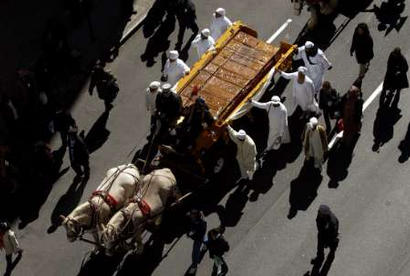
A group of caskets moves up Broadway today, holding remains beyond just bones
Yes, New York had slaves, and apparently they weren't all barbers and musicians.
Some of them, all still anonymous, are being returned tomorrow to the downtown Manhattan site of their burial in the seventeenth and eighteenth centuries
Twelve years after workers accidentally uncovered a burial ground for colonial era blacks in downtown Manhattan, the remains arrived Friday, headed for the empty lot where they were first discovered.Without a lot of in-the-face activism on the part of some dedicated New Yorkers over the last 12 years, we would hardly be aware of this part of our history even today.The remains, scheduled to be reinterred Saturday, arrived at Pier 11 at Wall Street on three police boats, in four small wooden coffins carved in Ghana. New York was the last stop on a five-city procession.
After a ceremony at South Street Seaport, the coffins were scheduled to be taken by procession to the African Burial Ground, located at the intersection of Duane and Elk streets.
Initially, the federal government tried not to comply with legal mandates about what to do in such a situation. But African American New Yorkers, including then Mayor David Dinkins, pressed the government to respect the remains found there and to find a way to honor this sacred space. After vigils and protests and religious observances and meetings held at the site by many in the community, construction was halted until all the remains could be unearthed and moved to be studied, with the promise that they would be re-interred back at the site.Brian Lehrer devoted part of his WNYC program this morning to the early history of Africans in New York and the events of today and tomorrow. What scientists found in 10 years study of the bones now being brought back to New York was evidence of disease and the stress of carrying heavy loads. It was established that most were born in Africa, specifically west and central Africa, and that both the death rate and the rate of reproduction were extrordinarily poor. The data suggests that the slaves were treated as expendable, and that attrition was addressed by bringing in more.
The NYTimes devoted half of a page to the story in yesterday's editions.
Not one of the skeletons in the burial ground could be linked to a person with a name, [urban anthropologist Dr. Sherrill D.] Wilson said. She says this is evidence that "these people were undocumented because they were viewed as a disposable population." Also, she said, almost half of the bodies found were children, which suggests "they were literally worked to death."Slavery ended in New York in 1827, but the story continues.
For more information, including that about events this week, see the African Burial Ground site.
A FOOTNOTE:
It was during the Brian Leher Show, in a section not included in the on-line report linked above, that I heard about several caucasian bodies found buried with the others.
How could that be, in a 6-acre cemetary which the city had made necessary because blacks were not allowed to bury their own in the same ground with whites?
In 1741 New York thought it was the victim of a slave conspiracy or uprising, because of a series of unexplained fires. When the hysteria had subsided, 31 slaves and 5 free whites, suspected sympathizers or accomplices, had been executed. The authorities decided to visit the worst possible humiliation upon the caucasians; they were interred along with the slaves.
Africans customarily buried their dead facing west. The bodies of the sympathizers appeared to be lovingly laid facing east, the custom of their time and people.
[image from REUTERS/Chip East]
I haven't seen it yet in a written report from the commercial media, but according to Atrios, Bush said just moments ago, "Free nations don't develop weapons of mass destruction."
Apparently those who watched CNN couldn't have missed this one.
There will be more to follow, I'm sure.
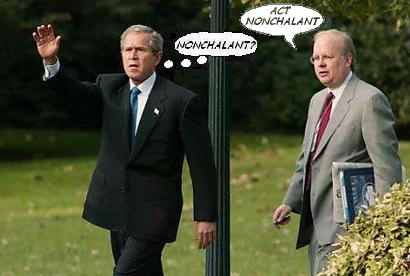
Le Scandale Plame: The Adventure Begins
It's been a very good day.
Technical note: Interestingly, the expression, "nonchalant," is no longer in the French language itself:
Etymology: French, from Old French, from present participle of nonchaloir to disregard, from non- + chaloir to concern, from Latin calEre to be warm -- more at LEE
Date: circa 1734
: having an air of easy unconcern or indifference
synonym see COOL
Sometimes you just gotta speculate. Sometimes you just can't wait for others to get around to telling you what's happening. Besides, I admit I have some spare time.
This comes from my brother in Washington, who writes, "Here is a 'must-read' article on the current Coup d'Etat." If you read billmon's ruminations, you'll wonder which Coup he means. Yes! I thought that would pique some interest!
The billmon post links to Brad De Long's amazing, much longer piece in order to speculate about why the CIA has taken upon itself such a heavy role in l'Affaire Plame. [I feel the urge to use French as much as possible these days.]
But the more I watch the story unfold, the more I think something deeper and darker is at stake. It seems the top career elite at the CIA, plus Tenet, has pulled out all the stops to try to bust up the Rove machine. That suggests they're worried about something much bigger than just bureaucratic turf or the WMD blame game.I can't do Bro justice with a proper credit for the heads-up, since he doesn't have a weblog, and because I have to protect his anonymity, but I know you'd really like him.
CORRECTION (October 2, 2003): My friend James W reminds me, "Costa Rica has not had an Army since 1948. (That reason alone puts Costa Rica high on my Good List.)"
Meanwhile, in other news [there's always other news], "US CUTS AID TO ALLIES WHO WON'T EXEMPT US FROM WAR CRIMES..." has been the headline story all day long on Common Dreams.
WASHINGTON -- The Bush administration today cut over $89 million in military aid to 32 friendly countries because they refused to exempt U.S. citizens and soldiers from the jurisdiction of the new International Criminal Court (ICC)--the world's first permanent tribunal to prosecute the perpetrators of war crimes, crimes against humanity and genocide.Strictly speaking, this isn't quite news, since I'm sure we had already heard some time ago that they were going to do this.Among the countries whose aid was cut were a number of new democracies in Central and East Europe--some of which have contributed troops to bolster the U.S.-led occupation in Iraq--as well as Brazil, Costa Rica, Peru, Venezuela, Ecuador, South Africa, and several other Latin American and African countries.
Nevertheless, it now provides evidence that it's not only bribery and blackmail but clearly also payback schemes which steer what passes for U.S. foreign policy these days. They must love us out there by now!
But of course we should know that's not the point, right?
And finally the country is beginning to understand why.
The essential story to this day, of one very-developing White House scandal, from today's editorial of the Minneapolis Star Tribune via atrios.
Call it Wilson-Plame-gate. It's not about cigars and blue dresses; it's about the security of this nation and the danger of revealing the identity of an undercover CIA operative. In a word, it is serious.And getting even more serious:
The Justice Department has responded affirmatively to Tenet's request for an investigation. But get this: When Justice informed the White House of the investigation Monday evening, it said it would be all right if the staff was notified Tuesday morning to safeguard all material that related to the case. The staff had all night to get rid of anything incriminating.Read the entire editorial.That incredible tidbit supports calls by Democrats and a slew of others for Attorney General John Ashcroft to appoint a special counsel to investigate this case. They're right: Ashcroft has no credibility in this, and neither does the White House, given its habitual effort to spin information, mislead the American people and smear anyone who disagrees with it. This developing scandal ultimately goes to the even more serious question of administration manipulation of intelligence on Iraq, where American soldiers continue to die almost every day in a campaign that looks increasingly like a bad mistake.
Oh yes, there's a welcome tribute to bloggers, specifically in a generous acknowledgement that it was they and their audiences that kept the Wilson/Plame story from going away.
One more thing. Can't we drop the "-gate", especially since this thing's bigger than an apartment building, and call just call it what it is, "treason"? Ok, maybe "the Plame affair" would do.